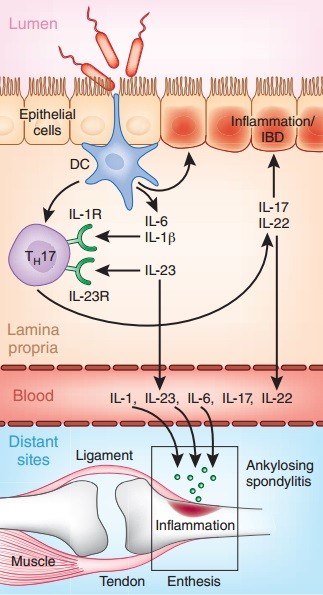博文
口腔不卫生,风湿惹上身
 精选
精选
|||
昨天,我谈到口腔细菌、漱口水和高血压的问题,有位署名为a3511260的博友在文后留言,为大家提供了一条非常有价值的线索:一种口腔细菌被证明是诱发类风湿性关节炎的“祸根”!为了让大家了解这个最新进展,我将该留言黏贴如下:
据新加坡《联合早报》25日报道,认真刷牙可保口腔健康,医学界也发现,刷牙刷得好,对心脏健康也有关联益处。最近美国一项研究又发现,认真刷牙可以帮助对抗关节炎。
美国路易斯维尔大学研究人员在《科学公共图书馆病原卷》上介绍说,诱发牙周疾病的一种主要细菌“牙龈卟啉单胞菌”,会产生一种特定的酶。在这种酶的催化下,某些特定蛋白质的“残基”(蛋白质上的特定单元)会转变为瓜氨酸。这时机体就会把这样的蛋白质误认作“入侵者”,诱发免疫反应。
对于风湿性关节炎患者来说,这种免疫反应就会带来慢性炎症,引起关节内的硬骨质及软骨损伤。研究人员说,关节炎患者如果口腔记忆体在上述病菌,就会连锁反应般加速关节炎的病程,加重病情。研究者因此认为,认真刷牙可以帮助对抗关节炎。
我根据这条线索找到了它的原文,这是2013年9月12日发表于PLoS Pathogens上的一篇原创论文,为Open Access,点击以下论文题目即可打开阅读并下载全文:
为便于介绍,下面分别列出该文的Abstract和Author Summary:
Rheumatoid arthritis and periodontitis are two prevalent chronic inflammatory diseases in humans and are associated with each other both clinically and epidemiologically. Recent findings suggest a causative link between periodontal infection and rheumatoid arthritis via bacteria-dependent induction of a pathogenic autoimmune response to citrullinated epitopes. Here we showed that infection with viable periodontal pathogen Porphyromonas gingivalis strain W83 exacerbated collagen-induced arthritis (CIA) in a mouse model, as manifested by earlier onset, accelerated progression and enhanced severity of the disease, including significantly increased bone and cartilage destruction. The ability of P. gingivalis to augment CIA was dependent on the expression of a unique P. gingivalis peptidylarginine deiminase (PPAD), which converts arginine residues in proteins to citrulline. Infection with wild type P. gingivaliswas responsible for significantly increased levels of autoantibodies to collagen type II and citrullinated epitopes as a PPAD-null mutant did not elicit similar host response. High level of citrullinated proteins was also detected at the site of infection with wild-type P. gingivalis. Together, these results suggest bacterial PAD as the mechanistic link between P. gingivalisperiodontal infection and rheumatoid arthritis.
Clinical and epidemiological data indicates that chronic periodontal disease (PD), one of the most prevalent infectious inflammatory disease of mankind, is linked to systemic inflammatory diseases such as cardiovascular diseases (CVD), rheumatoid arthritis (RA) and chronic obstructive pulmonary disease (COPD). Nevertheless, the causative mechanisms of association between PD and chronic inflammatory diseases are very poorly understood. Recent findings suggest a causative link between periodontal infection and rheumatoid arthritis viabacteria-dependent induction of a pathogenic response to citrullinated epitopes. In present study we show that infection with viable periodontal pathogen Porphyromonas gingivalis but not another oral bacterium (Prevotella intermedia), exacerbated CIA, as manifested by earlier onset, accelerated progression and enhanced severity of the disease, including significantly increased bone and cartilage destruction. The ability of P. gingivalis to augment CIA was dependent on the expression of a unique enzyme peptidylarginine deiminase, which converts arginine residues in proteins to citrulline. This knowledge may create new perspectives in the treatment and prevention of RA in susceptible individuals.
问题一:这项实验研究是否已经找到类风湿性关节炎的病因?
它并没有找到该病的病因,只是发现一种特定的口腔细菌——牙龈卟啉单胞菌(Porphyromonas gingivalis)可以加重小鼠胶原诱导关节炎(CIA)的病情。
问题二:这种口腔细菌为何能加重类风湿性关节炎的病情?
牙龈卟啉单胞菌分泌肽酰精氨酸脱亚胺酶(PPAD),它能将蛋白质中精氨酸转变成瓜氨酸,而瓜氨酸不是人体中天然存在的氨基酸,故含有瓜氨酸的蛋白质会作为外来抗原诱发自身免疫反应。在本病的临床检验中,抗环瓜氨酸肽(CCP)抗体是常用的类风湿性关节炎诊断指标。
问题三:这个研究结果的意义何在?
这说明口腔细菌不仅能导致牙周炎、牙龈炎,而且能导致全身性炎症,除了加重类风湿性关节炎的病情以外,可能还是心血管病甚至肿瘤发生的“催化剂”。因此,消灭口腔细菌、保持口腔卫生是确保身体健康的关键环节。
【背景】
说起类风湿性关节炎的症状,轻者疼痛难忍,出现关节变形,重者不能行走,只能卧病在床,但其病因一直不明,只知道与自身免疫有关,而且与肿瘤坏死因子-α(TNF-α)关系最密切。因此,该病的治疗主要是抑制免疫活性,即抗炎。过去常用的是化学抗炎药物(如水杨酸、吲哚美辛、布洛芬等),后来多采用生物抗炎药物(如肾上腺皮质激素等),最近已开始使用抗TNF-α单克隆抗体(单抗)。
然而,过去所有的抗风湿疗法都只能控制病情,但不能消除病灶,更不能修复受损的关节和滑膜,其根本原因就是不知道它的病因。2010年Immunity上发表一篇论文称,肠道寄居的分节丝状菌(SFB)可以诱发自身免疫性疾病——强直性脊柱炎。2011年Nature Medicine又撰文对上述论文进行注解式说明,并画出一张说明细菌感染与脊柱炎发生机制的示意图:
Commensal bacteria may have a role in producing inflammatory cytokines that can
worsen autoimmune disease in the joints. Gut Gram positive bacteria, such as SFB, induce IL-1, IL-6 and IL-23 in the mucosa and also a TH17
response, increasing IL-17 and IL-22. The release of these cytokines may initiate IBD, but, when overproduced, they may spill into the systemic circulation. This may promote inflammatory diseases in distal sites, such as the joints, perhaps through action upon joint-resident lymphoid cell populations. Altered sensitivity to IL-23 may predispose people to develop rheumatic diseases, such as ankylosing spondylitis.
上图旨在说明,肠道中的革兰氏阳性细菌SFB可以诱导黏膜细胞分泌白细胞介素1、6和23,刺激TH17应答,由此提高白介素17和22的含量。这些细胞因子可先引起炎症性肠病(IBD),然后过量白介素经血液循环溢出,导致身体远端(如关节)出现炎症性疾病。
在此思路引导下,我们发现饲喂大肠杆菌(非致病菌)居然也能引起小鼠关节滑膜炎,其症状与胶原诱导关节炎(CIA)十分相似。经分析,我们阐明了细菌感染、炎症诱导、一氧化氮激发、缺氧形成、血管新生、组织增殖、淋巴浸润等一系列病理过程。下面是2012年3月发表的该文摘要:
最近,我们发现,炎症激发的一氧化氮含量与蛋白质硝基化程度呈正相关,也就是一氧化氮含量升高,3-硝基酪氨酸的含量水平也随之升高。有趣的是,随着3-硝基酪氨酸的增加,抗环瓜氨酸肽(CCP)抗体却减少。目前我们还无法解释这个现象,希望与同行切磋交流。
https://blog.sciencenet.cn/blog-281238-772188.html
上一篇:肿瘤成因的“革命”:从遗传到表观遗传
下一篇:关爱女性健康:如何预防类风湿病?

